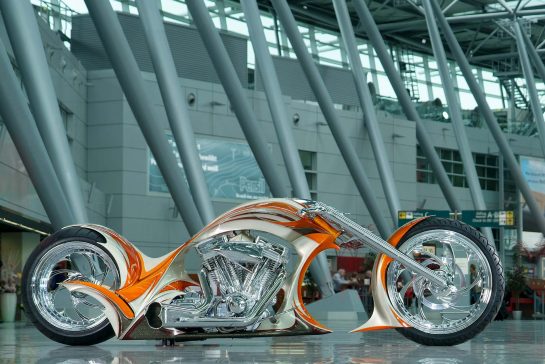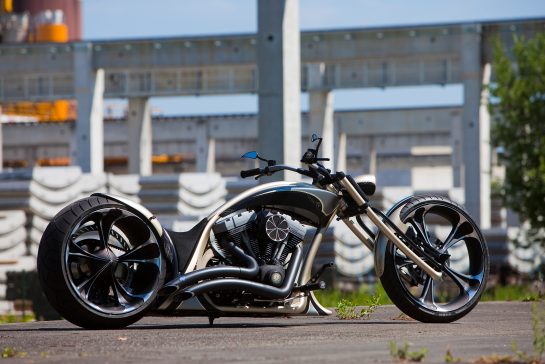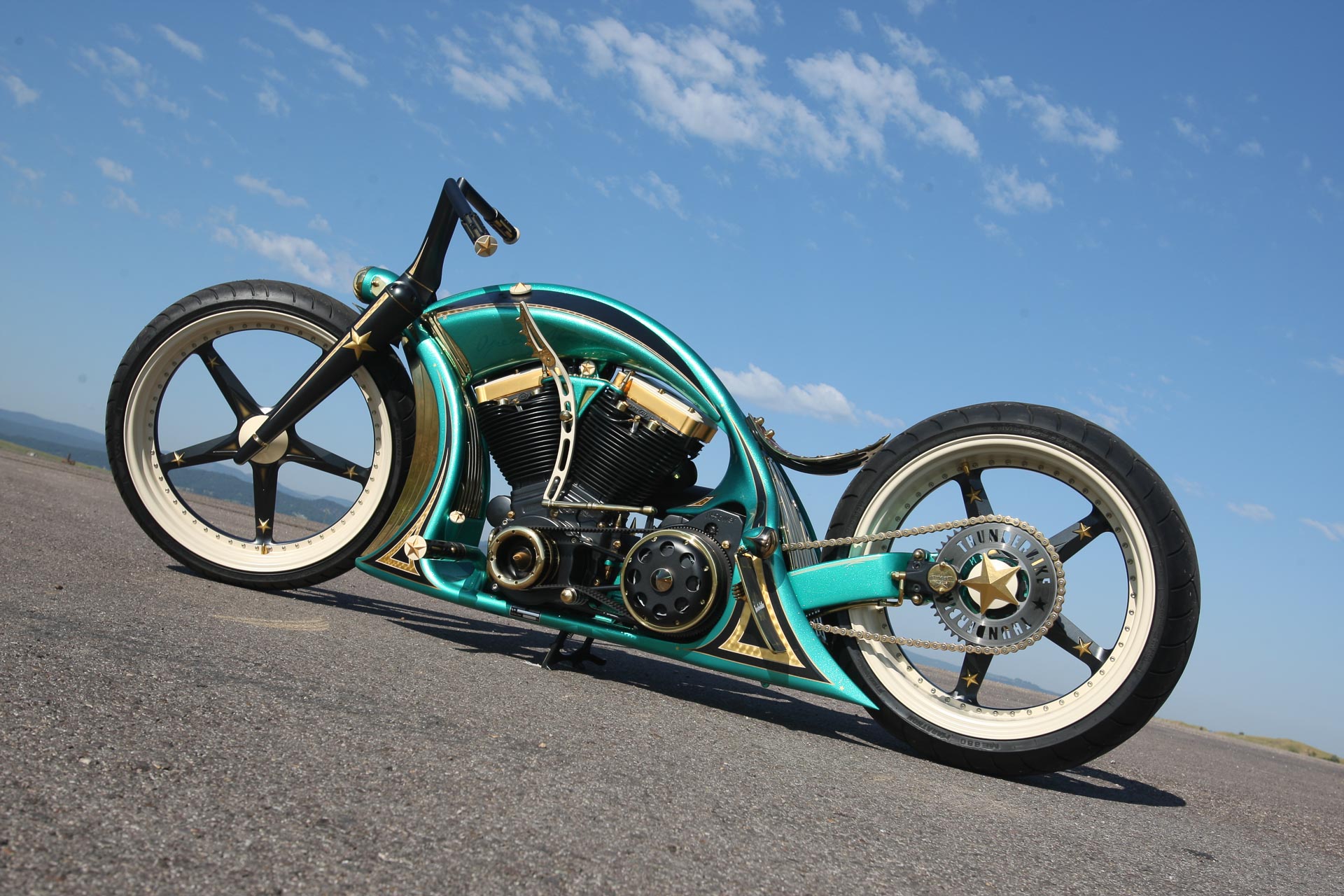- Home
- Custombikes
- TB Frames
- Specials
- Open Mind
Development, production of components and body made by Thunderbike
The construction period of the Open Mind was 3 months, the total development time about half a year. The entire development and production of all components as well as all body work was carried out exclusively by the team around Thunderbike. The operating elements such as gas, clutch, brake, gearshift, air suspension, etc. were combined with each other and not visibly integrated in fork and frame.
The result was a super clean overall impression, which distracts neither by screws, cables or lines from the design and deliberately creates the impression that it is an inedible study. The Spectacular show bike is driven and braked by an equally invisible friction roller drive. Air suspension at the front and rear lets the bike lift for driving. The paint system is 28 layers thick and interspersed with different sized metal pigments. All stripes are hand-lined (pinstriping).
- Construction Year 2008
- Engine S&S Super Sidewinder
- Capacity 124cui
- Power 120PS
- Carburetor S&S Super G
- Air Cleaner Crime Scene Choppers
- Ignition Altmann
- Exhaust Thunderbike Open Mind
- Gear Baker Torquebox 5-Speed
- Clutch NH-PowerAutomatik NH-Power
- Secondary Thunderbike Sprocket Brakde Discs
- Frame Thunderbike Open Mind
- Rake 34°
- Swingarm Thunderbike Singleside
- Suspension Tricky Air Ride
- Fuel Tank Thunderbike Open Mind
- Oil Tank Thunderbike (Front Spoiler)
- Grips Thunderbike Open Mind
- Brake Caliper K-Tech
- Footpegs Thunderbike Open Mind
- Electric Thunderbike Open Mind
- Heamdlamp Thunderbike Open Mind
- Taillight Crime Scene Choppers
- Seat Custom Leather
- Front End Thunderbike Open Mind (Air Ride)
- Whreels Thunderbike Open Mind 4.5×23 front & 9×21 rear
- Tires Avon 130/60-23 & Metzeler ME880 260/35-21
- Brake Disc Thunderbike Open Mind
- Painting by Ingo Kruse / Kruse Design
Nostalgia-free hi-tech in an uncompromising old-school look
Text by Michael Stein - Easyriders
This bike is “100% Hi-Skool”, explains Andreas Bergerforth, while at the moment the rest of the world likes to talk about “Old School”. Be that as it may, the bike is definitely in line with the trend. Because the aptly named Open Mind iron does not lack a good portion of vintage flair.
If you want to put something on your bikes that is really trendy at the moment, you have to get the inspiration from the time when sex was a safe affair and bikes were all the more dangerous. If the part is also to be a really remarkable hit, then it is important to banish all dusty ideas from the skull from the outset. So to actually follow a philosophy that deserves the title Open Mind.
And that’s exactly what Andreas and his guys did with their latest design, presenting completely nostalgia-free high-tech in an uncompromising old-school look. “The new generation of excessively large wheels was to be staged in a very special way,” says Andreas, and continues to report that, as the Hot Rod construction has shown, every effort had been made to get the chassis down as low as possible. This required a short and flat steering head as well as air suspension at the front and rear.
At the same time the bike should be ultra-clean. The handlebars were not to be seen with any cables, cables or levers, which is why a shift stick positioned on the left side of the tank was used in combination with an automatic clutch. The latter was supplied by NH Power, which had taken care of the primary unit in terms of technology, while Thunderbike was responsible for the design.
“The Open Mind has a semi-automatic. It is started and shifted without clutch actuation”.
As for the transmission, the Hamminkelner bet on Baker. The Moto is a S&S 124ci Super-Sidewinder. It is certainly not the only thing to mention that the Twin was completely disassembled for painting before installation. It is also worth mentioning that Andreas and his guys won the engine at the AMD European Championship of Custombike Building in 2006. They put the engine away for the time being, only to build something very special again later. So it’s hardly surprising that the Sidewinder was given completely gold-plated screws or brass covers. But once again back to the chassis. With the fork built by Thunderbike the special challenge consisted in the fact that the line for the level lift should be laid invisibly. The air had to be led through channels inside the steering mandrel into the upper fork bridge and from there pressed into the right and left spar. Andreas points out that such constructions must always take into account the effort involved in assembly and disassembly during any repair and maintenance work. Just getting the fork ready wasn’t child’s play. Because the special bridge had to be re-milled three times due to problems! As Andreas reports, in the first case there was a small hole in the area of the channels, which caused air to escape during the test. The second part was okay, the air pressure was constant and the spring and damper functions were okay. So the bridge could go to the polishing shop, where the last milling tracks should be smoothed. However, the underside had been ground so well that the air duct had been exposed at one point. “After I woke up again under the oxygen tent, we made the third attempt”, reports Andreas.
By the way, the fork was developed entirely on the computer of Herbert, the CNC specialist at Thunderbike. The biggest challenge was to design a completely new fork with air suspension in its upper part. Whereby the front wheel guidance is taken over by telescope rods. Only as the design for every single part, every bore, every bearing seat, every screw connection – simply everything! – Once the design had been thought through and converted into data, a milling program could be created. While the conventional way of constructing a machine is to go about the work after searching for the parts without much spring reading, at the beginning of a project like the Open Mind there is a lot of theory and development work. The first simple pencil sketches and drawings were created as a basis. “I use templates on which our graphic artist has installed the motor and wheels in proportion to each other.”
“Two compressors lift the lowered machine into the driving position at lightning speed.”
“I then try to put my idea on paper,” explains Andreas. In the following, a lot of erasing and tracing takes place until the graphic artist receives the finished draft after a few weeks in order to transfer it cleanly. What follows is a “meeting with the guys from practice”, as Andreas calls it, after which the design is reworked on the screen and the technical implementation is discussed. Experience has shown that the drawings produced so far are not very meaningful. In such discussions, “the third dimension” of the planned structure then grows, explains Andreas. Slowly but surely, concrete ideas would develop as to how the fork, frame, tank and so on would look later. At some point, the time has come for the first Autocat drawings, which are used to determine the castor from the steering head angle, fork rake and bridge offset. Once this is done, the work is divided into two workstations. On the one hand the already mentioned CNC specialist Herbert develops the corresponding components, on the other hand frame and sheet metal master Michael lets the rake mill rattling.
Once the coordinates for the height and length of the frame as well as the radii of the frame tubes have been determined, Michael gets straight to work: The first tubes are bent, a few stapling points are set, and the “third dimension” is visibly growing over foam and cardboard templates. As far as the sheet metal work at the Open Mind is concerned, the manufacturing of the tank was enormously time-consuming.
“The Open Mind proves that even the dead like billet parts and wide tires still work.”
As Andreas reports, countless stencils were made and suitable sheets cut out, rolled into shape, then stapled and welded at the very end. But there were still a lot of details to solve: Tank ventilation and the connections between the individual halves had to be considered. Also a suitable tank cap was not to be missing, and of course the whole should get a rubber bearing. Invisible, of course, with the same screw connections.
The Ride Out Shooting by Horst Rösler
The production of the seat shell and its springs, in which the individual parts were heated and then rolled into shape, proved to be particularly labour-intensive. Hardly less effort was put into the brass ribs. As you can see on the pictures, they are located in the front area and above the oil tank hidden in the front spoiler as well as in front of the fuel tank and under the seat. For each of these ribs, a large number of templates and models were once again produced in order to arrive at the final shapes, which were then cut from brass.
“Again and again, everything has to be installed and removed, adapted and installed and removed again. Cardboard stencils, wooden stencils, sheet metal stencils, the whole thing endlessly…”, says Andreas.
Oh, before we forget – here is the final solution to a question you may have been asking yourself all along: If you are looking for the front deceleration components, you should know that the bike has really no brake at the front! How was it with the times, when the motorcycles were still dangerous?
But all excessive efforts should not go unrewarded… because Thunderbike’s Open Mind made its first big appearance at the Mainzer Custom Chrome Show, which once again provided the setting for the European Championship of Custombike Building initiated by the dealer magazine “American Motorcycle Dealer” (AMD). In the freestyle class, one of the three tickets to the AMD World Championship had to be won, which will again take place in August in Sturgis. Andreas Bergerforth and his team had landed in first place in the freestyle category and at the same time had secured the European Champion title awarded by the American Motorcycle Dealer as well as the participation in Sturgis.
You can only congratulate them and keep your fingers crossed!
The Sturgis USA Shooting by Horst Rösler
You can find Thunderbike Parts and original Harley-Davidson Parts in our online shop.



























































